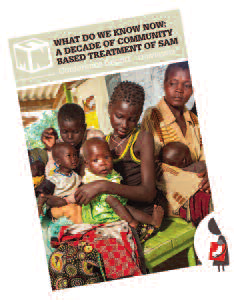What we know now: a decade of community-based SAM treatment
 Summary of meeting1
Summary of meeting1
In 2010, a group of nutrition organisations (ACF, Save the Children, Concern Worldwide, International Medical Corps, Helen Keller International and Valid International) came together to create the Coverage Monitoring Network (CMN), aiming to increase the capacity of nutrition programmes to assess their treatment coverage and to understand the main barriers and boosters to access. The CMN championed the use of coverage as a proxy measure of the health and robustness of severe acute malnutrition (SAM) treatment services and in measuring it, the CMN started to provide a picture of the quality of SAM treatment services today.
One of the stated objectives of the CMN project was to build on this growing evidence, creating spaces in which trends are reviewed, common barriers are identified and assessed, and lessons can be learned, through the implementation of coverage assessments around the world. To do so, however, the project would need to go beyond coverage and explore the factors influencing it. This realisation led the CMN to open these learning spaces to the review of emerging lessons on SAM treatment as a whole.
The first of such events took place in London on October 17th and 18th, 2013, as a co-sponsored event between the CMN, UNICEF, the CMAM Forum and World Vision. Under the title “What We Know Now: A Decade of Community-based SAM Treatment”, the conference brought together over 170 academics, practitioners and policy-makers from a range of non-governmental organisations (NGOs), United Nations (UN) agencies, academic institutions and national governments. What began as a simple ‘lessons learned’ exercise rapidly grew into a broad review of the state of SAM treatment today, and the start of a process to identify key areas for future action.
At the end of the two-day conference, a series of priority areas were identified, divided in seven different streams (Institutional Architecture, Financing, Government, Supply Chain, Treatment, Nutrition Information and Community, Access & Demand). In the weeks following the conference, partners continued to refine these areas of future work and begun making specific commitments to contribute to their development and implementation. The conference was thus the beginning of a process to strengthen SAM treatment through prioritisation and coordination of efforts by the international humanitarian community.
A copy of the report is included with this edition of Field Exchange. The meeting report is available at: http://www.coverage-monitoring.org/wp-content/uploads/2014/02/CMN-report_Web.pdf
For more information, contact: Jose Luis Alvarez, ACF, email: j.alvarez@actionagainsthunger.org.uk
1What We Know Now: a Decade of Community-based Treatment of Severe Acute Malnutrition. Conference Report. 17-18 October, 2013. Coverage Monitoring Network

